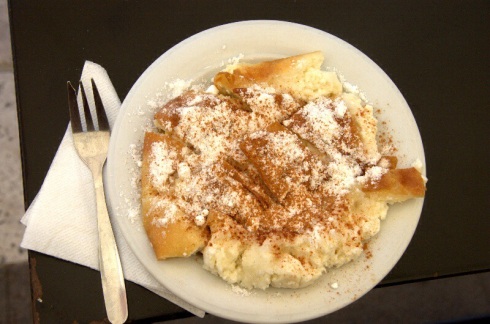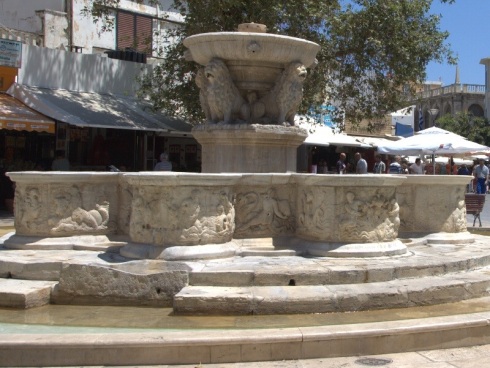Our fickle southern wind has returned, sending outdoor umbrellas crashing, tearing delicate buds from citrus trees, and making Crete’s usually playful dogs cower. But despite the gusts, the sun is out and we are sitting at the cafe Fillo. . .sophies overlooking the 16th century Venetian Fountain of Lions in the central square of the island’s capital Heraklion, named after Herakles in honor of his defeat of a ferocious bull that had terrified the ancient Minoan countryside, eating Bougatsa.
I love Bougatsa and have it way too often whenever I’m in Athens. But this Boutatsa is nothing like any I’ve had before, and I’m convinced it alone was worth the overnight ferry that we took to get here.
Most Bougatsas I’ve eaten have been pockets of sturdy phyllo dough enclosing custard, dusted with cinnamon and powdered sugar. They are served wrapped in a square of wax paper, perfect for snacking and strolling. This Bougatsa had all the essential ingredients — but it arrived cut into small pieces, its filling spilling out from airy phyllo sheets onto a small plate. And, better yet, we could choose between the creamy custard filling to which I have grown accustomed, or a Myzithra filling that has now become my hands down favorite.
I’ve been told that the two places offering the tastiest Bougatsas on all of Crete are the cafe where we are sitting, Fillo . . .sofies, and its next door competitor, Kirkor. Both cafes have been operating since 1922, when their original owners came as refugees to Heraklion from Smyrna. Fillo . . .sofies is now run by the founder Apostolos Salkinitzis’ grandson, Ioannis, who is deftly enticing five hungry-looking German tourists to one of his remaining open tables.
Giorgos Kteniadakis, whose wife Agnes and her business partner Zsuzsa run a fabulous restaurant in Archanes (more on that in the next post!) is from Heraklion, and he said that folks here eat more Bougatsas than those from the rest of Greece combined. “We eat them on Easter and Christmas and New Year’s, on saints’ days and civic holidays, on name days and wedding days,” he said. I calculate that that covers just about every day of the year, give or take a few sleepy Mondays in February.
Giorgos said his grandmother made dozens and dozens of Bougatsas at home for every celebration, holy and mundane. I will ask if he remembers the recipe and if he would be willing to share it. In the meantime, if you have your grandmother’s or grandfather’s or brother’s or aunt’s or maybe even your own recipe, please please please send it my way!




I really like this article. As a non-Greek I am a bit mixed up between Bougatsa and Galaktoboureko. Can anyone tell me the difference between the two?
I would love a recipe for both of them and also wanted to ask if you can recommend any Greek cookbooks. Love your site, Thank you!
Thank you for your message!p, Fiona!
To my knowledge, Bougatsas are thinner, made by layering a creamy custard filling in between sheets of phyllo with a sprinkling of cinnamon and powdered sugar on top. I eat them for breakfast or with coffee in the late afternoon. Galaktopoureko is also made by baking custard between sheets of phyllo, but it’s a granier, semolina custard. The Galaktopoureko is also flavored with a citrus-scented syrup, unlike the Bougatsa. I eat Galaktopoureko for dessert.
As for
cookbooks, I can recommend Michael Psilakis How to Roast a Lamb (I use this one frequently and he offers interesting and tasty twists on traditional dishes), Aglaia Kremezi’s Foods of the Greek Islands (she has a new one out Mediterranean Vegetarian Feasts which I will order as soon as I return home), Susanna Hoffman’s The Olive and the Caper which offers stories as well as recipes and gives you a sense of the place each recipe comes from, and Diane Kochilas’ The Glorious Foods of Greece for a wonderful introduction to the long history and great regional variety of Greek cooking.
These are my current favorites but your message has prompted me to go to the bookstore and see what other gems I can find!